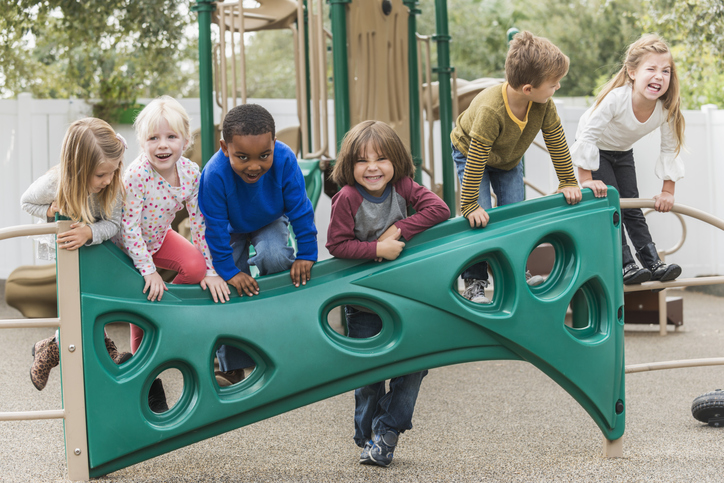 |
| Over two-thirds of the myopic children in this study achieved a 0.05mm axial length shortening through red-light therapy. Photo: Getty Images. |
Researchers recently tested a new strategy for myopia control in children called low-level red-light therapy, abbreviated as RLRL, that seemed to show promise. The approach involves delivering light to the retina directly, repeatedly, for a short duration. Bright light exposure outdoors has been demonstrated to be protective for myopia development, but the authors pointed out in their paper that certain approaches, such as renovating classrooms with glass walls and ceilings, are expensive and not necessarily practical.
They used a device that emits red light at a wavelength of 650nm to try to simulate this effect instead. “It has already been approved and widely used for amblyopia treatment in China,” the authors wrote in their paper. They selected this device based on unpublished anecdotal findings where choroidal thickness, blood flow and axial elongation stabilization were observed in children who used the device for amblyopia treatment.
The multicenter, randomized, parallel-group, single-blind clinical trial enrolled a total of 264 children between the ages of eight and 13 between July and August 2019. All subjects had myopia with a cycloplegic spherical equivalent refraction (SER) of -1D to -5D, astigmatism ≤2.5D, anisometropia ≤1.5D and BCVA ≥0.0logMAR (Snellen 1.0 or 20/20).
The researchers assigned children randomly to the intervention group to receive RLRL treatment plus single-vision spectacle (SVS) or to the control group to receive SVS only. The RLR treatment was done with a desktop light therapy device that emitted red light at a wavelength of 650nm, 1,600lux and 0.29mW for a 4mm pupil. The tests were administered at home under parental supervision. Test sessions lasted three minutes and were done twice daily at a minimum interval of four hours, five days per week.
The researchers included 246 of the 264 children (93.2%) in their analysis (RLRL group n=117, SVS group n=129). Here are some of their findings:
The adjusted 12-month axial elongation and SER progression were 0.13mm and -0.2D for the RLRL group and 0.38mm and -0.79D for the SVS group, respectively.
The difference between groups in axial elongation and SER progression was 0.26mm and -0.59D, respectively.
The researchers reported no severe adverse events, functional visual loss (by BCVA) or structural damage (observed on OCT).
“Orthokeratology, specially-designed spectacles and atropine eye drops are the most common optical and pharmacological interventions for myopia control,” the researchers wrote in their paper. Though studies show these methods achieve between 30% and 59% efficacy in myopia control, the researchers pointed out that ortho-K has a “small but significant risk of developing sight-threatening corneal infection, and compliance with wearing a tight contact lens every night can be challenging.” Additionally, they noted that atropine, used at 0.01% to 0.05% concentration, has a 50% efficacy in myopia control.
“In addition to orthokeratology and atropine eye drops, two recent innovatively designed lenses which impose myopic defocus on the retina, the Defocus Incorporated Multiple Segment (DIMS) lens and Highly Aspherical Lenslet Target (HALT) lens, have shown strong myopia-controlling effects of 52% and reduced axial elongation by 62% when compared over two years with SVS. A further report has shown that this myopia control effect is sustained in the third year. While study design differences make direct comparison difficult, the RLRL efficacy results reported here appear at least competitive with these other treatment modalities,” the team said.
“In our study, we demonstrate that RLRL treatment was able to achieve greater than 0.05mm axial length shortening in 70.1% of participants at one month and 31.6% at 12 months,” they continued, noting that AL measured by IOLMaster is “generally accepted to be accurate with measurement error within 0.05mm and thus observed axial shortening cannot be fully explained by measurement error alone.” They also found choroidal thickness changes at two of their study sites and increasing thickness by an average of 16.1µm at the one-month follow-up visit. “Axial shortening was measured as -0.04mm at this visit; axial shortening therefore cannot be fully explained by choroidal thickening either,” they wrote. “As recent evidence confirms scleral hypoxia as a promoter for scleral remodeling and myopia development, we hypothesized that the RLRL treatment increases blood flow and metabolism of the fundus, thus ameliorating scleral hypoxia and restoration of scleral collagen levels.”
Additionally, they noted that treatment efficacy increased with improved treatment compliance. “This strong dose-response effect may further support the efficacy of RLRL on myopia control,” they wrote, “and more importantly, highlight the imperative of setting up a proper incentive system to encourage children to use the device and maximize treatment efficacy. This strong dose-response effect may also imply that an extension of the treatment duration from three minutes to a longer treatment time per session may result in improved treatment efficacy.” They noted that so far nothing suggests extending treatment time is unsafe.
The authors concluded that RLRL is a promising and effective new alternative treatment for myopia control. “Further research, however, with double-masking and placebo control is needed to understand its long-term efficacy and safety, rebound effects, optimal treatment strategies (wavelength, power, duration, frequency of treatment) and potential underlying mechanisms,” they wrote.
Jiang Y, Zhu Z, Tan X, et al. Effect of repeated low-level red-light therapy in myopia control in children: a multicenter randomized controlled trial. Ophthalmology. December 1, 2021. [Epub ahead of print]. |


